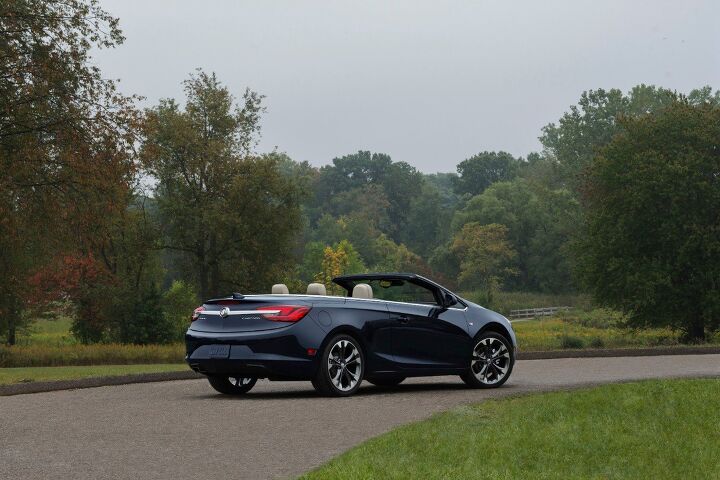A Buick Is in Danger

The Buick Cascada, known to Europeans as the Opel Cascada, appeared on North American shores for the 2016 model year, offering buyers (and renters) a pleasant, four-seat replacement for the discontinued Chrysler 200 drop-top.
Now wholly owned by France’s PSA Group, not General Motors, Opel plans to ditch the model once 2019 is up, meaning America stands to lose its last non-sports car convertible. It would also knock the Buick brand down to five models.
Opel announced Tuesday it would stop building the Cascada, introduced in Europe for 2014, after 2019. The Polish-built convertible and two other small cars “will not be replaced after the end of their life cycles,” the company said.
That seems to kibosh the idea that Opel could continue funnelling Cascadas to Buick, even after dropping the model from its own lineup. The newly Frenchified brand plans to go deeper into crossovers and electrification while dropping slower-selling cars, a strategy that seems to be a template followed by every automaker under the sun.
A Buick spokesman contacted by Motor Authority said the brand has nothing to announce about the model’s American future, but did mention that the Cascada remains an important part of the Buick family. The model draws a higher percentage of new customers to the Buick brand than any other model, the spokesman claimed. Still, the model doesn’t bring in a huge volume of buyers.
By far the slowest selling model in Buick’s lineup, Cascada volume fell 25 percent over the first nine months of 2018. A niche car, the Cascada amounted to 2.2 percent of Buick’s 2018 sales, and that’s after rounding up. The first three quarters of 2017 shows a Cascada take rate of 2.8 percent.
While the model was seldom talked about (it offered a single powertrain consisting of a turbocharged 1.6-liter four-cylinder making 200 hp and 207 lb-ft, or 221 lb-ft in overboost mode), it did provide the Buick brand with a point of interest. Something GM’s other divisions — and indeed, those of other Detroit Three automakers — couldn’t claim. Should the model disappear, the brand becomes less interesting than it already is.
[Image: General Motors]

More by Steph Willems
Latest Car Reviews
Read moreLatest Product Reviews
Read moreRecent Comments
- Mebgardner I owned 4 different Z cars beginning with a 1970 model. I could already row'em before buying the first one. They were light, fast, well powered, RWD, good suspenders, and I loved working on them myself when needed. Affordable and great styling, too. On the flip side, parts were expensive and mostly only available in a dealers parts dept. I could live with those same attributes today, but those days are gone long gone. Safety Regulations and Import Regulations, while good things, will not allow for these car attributes at the price point I bought them at.I think I will go shop a GT-R.
- Lou_BC Honda plans on investing 15 billion CAD. It appears that the Ontario government and Federal government will provide tax breaks and infrastructure upgrades to the tune of 5 billion CAD. This will cover all manufacturing including a battery plant. Honda feels they'll save 20% on production costs having it all localized and in house.As @ Analoggrotto pointed out, another brilliant TTAC press release.
- 28-Cars-Later "Its cautious approach, which, along with Toyota’s, was criticized for being too slow, is now proving prescient"A little off topic, but where are these critics today and why aren't they being shamed? Why are their lunkheaded comments being memory holed? 'Who controls the past controls the future. Who controls the present controls the past.' -Orwell, 1984
- Tane94 A CVT is not the kiss of death but Nissan erred in putting CVTs in vehicles that should have had conventional automatics. Glad to see the Murano is FINALLY being redesigned. Nostalgia is great but please drop the Z car -- its ultra-low sales volume does not merit continued production. Redirect the $$$ into small and midsize CUVs/SUVs.
- Analoggrotto Another brilliant press release.



































Comments
Join the conversation
A hodgepodge of old Astra bits with old Insignia/Regal style rear lights. The car the new Saab 9-3 cabrio could've been (and rumour has it that it started off as, before GM got rid of Saab) PSA Peugeot-Citroen are looking to axe all GM platform models and replace the profitable ones with home-grown platformed models. They're also axing the Viva (aka Spark) and Adam small cars, the former likely to be replaced with something on the same line as the 108/C1/Toyota Aygo. As someone who saw Chrysler Europe get snapped up, badge engineered then wound down, it is scarily like history repeating. At least it worked out well for Peugeot, the Horizon (of which the Plymouth / Dodge Omni were similar in the same way as European and US Ford Escorts were vaguely similar...) replacement Arizona became the 309 and gave Peugeot a foothold in the compact family hatchback market, where they are popular to this day - stopping the numbering increment with the last few generations of 308. Keep an eye on the Regal, US and Australia sales aren't living up to expectations (thanks to crossovers and the Kia Stinger...), PSA would be happy enough to either axe the GM platformed Insignia or replace it with a 508-based model.
it's a really nice car.......but that is the stupidest name ever put on an american car.